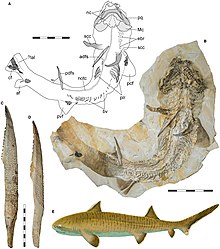
Elasmobranchii is a subclass of Chondrichthyes or cartilaginous fish, including modern sharks, rays, skates, and sawfish. Members of this subclass are characterised by having five to seven pairs of gill slits opening individually to the exterior, rigid dorsal fins and small placoid scales on the skin. The teeth are in several series; the upper jaw is not fused to the cranium, and the lower jaw is articulated with the upper. The details of this jaw anatomy vary between species, and help distinguish the different elasmobranch clades. The pelvic fins in males are modified to create claspers for the transfer of sperm. There is no swim bladder; instead, these fish maintain buoyancy with large livers rich in oil.

Yangchuanosaurus is an extinct genus of metriacanthosaurid theropod dinosaur that lived in China from the Middle Jurassic to Late Jurassic periods, and was similar in size and appearance to its North American and European relative, Allosaurus. Yangchuanosaurus hails from the Upper Shaximiao Formation and was the largest predator in a landscape that included the sauropods Mamenchisaurus and Omeisaurus and the stegosaurs Chialingosaurus, Tuojiangosaurus and Chungkingosaurus. This theropod was named after the area in which was discovered, Yongchuan, in China.

Caturus is an extinct genus of predatory marine fishes in the family Caturidae in the order Amiiformes, related to modern bowfin. It has been suggested that the genus is non-monophyletic with respect to other caturid genera.

Ophthalmosaurus is a genus of ichthyosaur known from the Middle-Late Jurassic. Possible remains from the earliest Cretaceous, around 145 million years ago, are also known. It was a relatively medium-sized ichthyosaur, measuring 4 m (13 ft) long and weighing 940 kg (2,070 lb). Named for its extremely large eyes, it had a jaw containing many small but robust teeth. Major fossil finds of this genus have been recorded in Europe with a second species possibly being found in North America.

Machimosaurus is an extinct genus of machimosaurid crocodyliform from the Late Jurassic and Early Cretaceous. The type species, Machimosaurus hugii, was found in Switzerland. Other fossils have been found in England, France, Germany, Portugal, Switzerland and Tunisia. Machimosaurus rex is the largest named teleosauroid and thalattosuchian, with an estimated length of up to 7.15 m (23.5 ft). Machimosaurus is the largest known crocodyliform of the Jurassic.

Hybodus is an extinct genus of hybodont that lived from the Middle Triassic to the Late Cretaceous periods. Species closely related to the type species Hybodus reticulatus lived during the Early Jurassic epoch. Numerous species have been assigned to Hybodus spanning a large period of time, and it is currently considered a wastebasket taxon that is 'broadly polyphyletic' and requires reexamination.
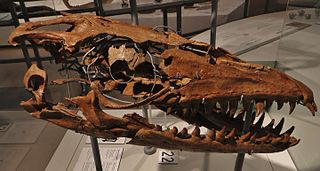
Prognathodon is an extinct genus of marine lizard belonging to the mosasaur family. It is classified as part of the Mosasaurinae subfamily, alongside genera like Mosasaurus and Clidastes. Prognathodon has been recovered from deposits ranging in age from the Campanian to the Maastrichtian in the Middle East, Europe, New Zealand, and North America.
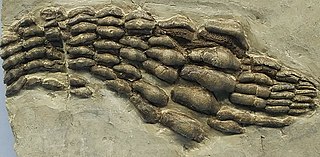
Acrodus is an extinct genus of hybodont spanning from the Early Triassic to the Late Jurassic. It was durophagous, with blunt, broad teeth designed for crushing and grinding. Some Middle Triassic species have been suggested to have grown to lengths of 1.8–2.5 metres (5.9–8.2 ft). Species are known from both marine and freshwater environments, with all Middle and Late Jurassic species only known from freshwater.
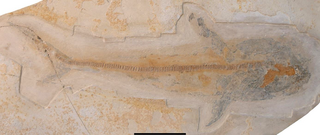
Ptychodus is a genus of extinct large durophagous (shell-crushing) lamniform sharks from the Cretaceous period, spanning from the Albian to the Campanian. Fossils of Ptychodus teeth are found in many Late Cretaceous marine sediments worldwide.
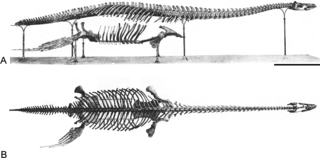
Brancasaurus is a genus of plesiosaur which lived in a freshwater lake in the Early Cretaceous of what is now North Rhine-Westphalia, Germany. With a long neck possessing vertebrae bearing distinctively-shaped "shark fin"-shaped neural spines, and a relatively small and pointed head, Brancasaurus is superficially similar to Elasmosaurus, albeit smaller in size at 3.26 metres (10.7 ft) in length as a subadult.

Hybodontiformes, commonly called hybodonts, are an extinct group of shark-like cartilaginous fish (chondrichthyans) which existed from the late Devonian to the Late Cretaceous. Hybodonts share a close common ancestry with modern sharks and rays (Neoselachii) as part of the clade Euselachii. They are distinguished from other chondrichthyans by their distinctive fin spines and cephalic spines present on the heads of males. An ecologically diverse group, they were abundant in marine and freshwater environments during the late Paleozoic and early Mesozoic, but were rare in open marine environments by the end of the Jurassic, having been largely replaced by modern sharks, though they were still common in freshwater and marginal marine habitats. They survived until the end of the Cretaceous, before going extinct.
Archaeoistiodactylus is an extinct genus of wukongopterid pterosaur from the Middle Jurassic of China.

Acamptonectes is a genus of ophthalmosaurid ichthyosaurs, a type of dolphin-like marine reptiles, that lived during the Early Cretaceous around 130 million years ago. The first specimen, a partial adult skeleton, was discovered in Speeton, England, in 1958, but was not formally described until 2012 by Valentin Fischer and colleagues. They also recognised a partial subadult skeleton belonging to the genus from Cremlingen, Germany, and specimens from other localities in England. The genus contains the single species Acamptonectes densus; the generic name means "rigid swimmer" and the specific name means "compact" or "tightly packed".

Scheenstia is an extinct genus of neopterygian ray-finned fish from the Late Jurassic–Early Cretaceous of Europe. Fossils have been found in both marine and freshwater environments.

Meristodonoides is an extinct genus of hybodont known from the mid-late Cretaceous, with potential records dating back to the Jurassic. It is one of a number of hybodont genera composed of species formerly assigned to Hybodus.

Paracestracion is an extinct genus of heterodontiform sharks from Early Jurassic to Early Cretaceous-aged rocks of England, France, Germany and Luxembourg. The genus was first described in 1911 by Ernst Hermann Friedrich von Koken in Karl Alfred von Zittel.
Tribodus is an extinct genus of hybodont. It lived during the mid Cretaceous (Albian-Cenomanian) with fossils being known from northern South America, North Africa, and southern Europe.

The Jaisalmer Formation is a Middle to Late Jurassic-aged geologic formation located in India near the city of Jaisalmer that consists mainly of marine deposits. The formation was first identified and defined by geologist Richard Dixon Oldham in 1886.

Strophodus is an extinct genus of durophagous hybodont known from the Triassic to Cretaceous. It was formerly confused with Asteracanthus.

Planohybodus is an extinct genus of hybodont, known from the Middle Jurassic-Early Cretaceous (Bathonian-Barremian) of Europe and the Indian subcontinent. Fossils have been found in marine as well as freshwater environments. The genus contains 3 confirmed species, two of which were originally assigned to the genus Hybodus. Possible records have been reported from the Late Jurassic of Mexico, the Early Cretaceous of Brazil and the Late Cretaceous (Santonian) of North America, but these are unconfirmed. Planohybodus peterboroughensis is suggested to have reached lengths of 2–3 metres (6.6–9.8 ft). A specimen of the ammonite genus Orthaspidoceras from the Late Jurassic of France has been found with an embedded tooth of Planohybodus, suggesting that while the teeth of Planohybodus were adapted to tearing soft bodied prey, it would attack hard-shelled prey at least on occasion.
